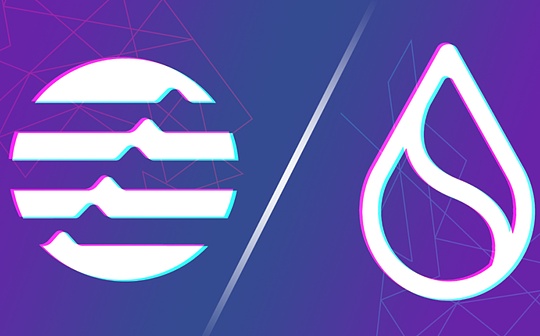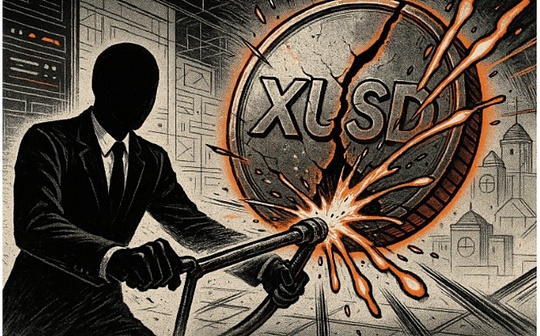
Author: YBB Capital Researcher Zeke
Foreword
Recently, the market has become increasingly cold, and many OGs in the circle have also begun to shake the significance of the industry.To put some personal feelings, I always feel that the reason why many great visions in the past have been “faked” is because these visions have not been logical from the beginning.DAPPs outside non -financial applications always try to cover up the product itself is not good enough to cover up decentralized value.But the fact is that they let me do not believe in Google, Twitter, YouTube, and believe that their multiple signature wallets and stand -alone servers are safe enough.Many visions are not for false, but have never been truly verified.I still believe that most of the vision is not so magnificent, it has its meaning. They may just need enough to support the bottom.In the end, at least one person can be provided in decentralization and a good experience comparable to Web2.Just as Ton and Solana have also been despised, but now they are gradually catching up with the elder brother in many aspects. The public chain that carrys applications needs innovation, which will promote industry progress in each cycle.Therefore, we will explore a public chain type that has not been valued for a long time today, MOVE.
1. MOVE
The MOVE programming language was originally born in Meta’s abandonment project DIEM (originally called libra). The project was originally aimed at creating a more stable and more regulatory stablecoin as the base of its vision of the Yuan universe.However, it is contrary to his wishes that the project has been under strong opposition and continuous pressure from global regulatory agencies.Regulators are worried that the size of DIEM and the huge user base of Facebook may pose a threat to financial stability, monetary policy and data privacy, and the pressure led by the Bayeng government eventually led Meta to give up the DIEM project.
Fortunately, the core of DIEM has not been abandoned. Different factions split out of the original team are still insisting on digging and development of MOVE, and now it has evolved into the MOVE Gemini SUI and APTOS that we know.In addition, there are LINERA, which is still among the crickets, and other public chain projects such as Movement recently announced by Movement.
So why is the remaining temperature of a brave project so great?Move, as a Web2 head factory, a answer sheet of the blockchain programming language, does not need to say more about its skills. In the design, it has also made many performance and security issues around the existing blockchain programming language (especially solidity).Reflection, its design goal is to tailor a type system for asset management and access control execution.My personal summary is three simple points:
-
Security: The premise of Move language design lies in security. It uses static type inspection and resource management to prevent common security vulnerabilities, such as overflowing errors and repeat attacks.Compared with other language virtual machines, MOVE supports a variety of security functions. The figure below is referenced by NANSEN comparison.
>
-
Combined: support modularity and combination, allow developers to easily create and combine different smart contracts to build more complex applications.
-
Performance: The virtual machine of the MOVE language is optimized (supporting parallel, memory management, and compiler optimization), which can efficiently execute smart contracts, thereby increasing transaction speed and throughput.
At the moment when the modular EVM public chain is full of the market, MOVE is actually a brave attempt.I am talking about three points of appeal, you may also have seen similar in the introduction of many public chain projects. I recommend it to experience it in person to like these texts.
2. SUI
>
2.1 architecture
As one of the Geminic Stars, it has been criticized for airdrop problems and tokens in the early days of launch.But aside these problems, only the project itself.The SUI is at least good enough in terms of performance and experience, and the performance in the game is extremely good, which is inseparable from the improved architecture design of the mainstream.Here I briefly describe the innovation of SUI in architecture:
-
Object storage model: This component is the core component of SUI to improve MOVE. The so -called object storage model is an object that stores data as independent. Each object has the unique identifier.Unlike the traditional database system, the object storage model does not have a fixed data structure, and can store various types of data, such as text, images, video, audio.This model allows parallel execution and horizontal expansion (adding nodes to expand the storage capacity), and SUI is designed to be designed around the model.
-
Cause and effect: Ensure that the execution order of the transaction is in line with causality, and data conflict and inconsistency are avoided.This allows SUI to process a large number of concurrent transactions and maintain the consistency of data.
-
Narwhal 和Bullshark 共识引擎: Sui 使用Narwhal 和Bullshark 作为其共识引擎,Narwhal 负责交易排序和验证,其工作原理是通过维护本地交易池,根据交易的因果关系进行排序并广播,确保所有节点都拥有相同且Effective transaction order.Bullshark will vote on the trading list when receiving the sorted trading list after receiving the narwhal sorting, and use the Byzantine tolerance consensus to ensure that all nodes are consistent with the trading list.
-
SUI Move: SUI expands on the basis of MOVE language, adding new features, such as supporting NFT, asset management and data storage.
-
SUI framework: SUI provides a complete set of framework to help developers quickly build and deploy applications.The framework includes various tools and libraries, such as Sui Wallet, Sui SDK and SUI CLI.
-
Low latency and high throughput: The MySticeTi protocol passes the parallel block proposal and optimization message transfer process, which significantly reduces consensus delay and improves network throughput.This enables the SUI blockchain to deal with tens of thousands of transactions per second, and the end -to -end delay is much lower than one second;
-
Examine resistance: MysticeTi protocol allows multiple verifications to propose block parallel to improve the network review resistance;
-
Leaders who are not available: Submit rules to allow tolerated leaders (when the leader node fails, the system will automatically elected a new leader to replace its responsibilities) without significantly increased the submission delay.
-
Complexity: The design of the MySticeTi protocol is relatively complicated, and more in -depth technical understanding is required to fully grasp its operating mechanism;
-
Security: Although the MySticeTi protocol performs well on the test network, its security still needs to be further verified in practical applications;
-
Scalability: The scalability of the MySticeTi protocol still needs to be further observed to ensure that it can adapt to the growing network scale and transaction volume that is growing in the future.
-
Account Object: The account object is the basic unit of the account in the SUI.Each account object has a unique account ID, which contains the attributes and behaviors of the account;
-
Account data: Account data is part of the core component of the account object.It contains the basic information of the account, such as account ID, public key, and private key pairs;
-
Transaction Context: The context of the transaction is the basic unit of transactions in SUI.It contains transaction -related information, such as transaction ID, account ID, and transaction data;
-
Account logic: Account logic is a collection of behaviors and rules of accounts in SUI.It defines how the account handles transactions and manage its state.
-
Transaction creation: Users create a transaction and send it to the SUI network;
-
Transaction verification: The effectiveness and integrity of the SUI network verification transaction;
-
Account search: SUI network finds the corresponding account object according to the account ID during the transaction;
-
Account logic execution: SUI network execution account logic to handle transaction and update account status;
-
Transaction confirmation: SUI network confirms the result of the transaction and write it into the blockchain.
-
Preset order execution: Block-Stm depends on the preset order of transactions in the block. All transactions must be executed in this order to ensure the consistency of the final state;
-
Optimistic concurrency control: Block-STM will be optimisticly executed in parallel trading, assuming that there will be no conflict.Optimism and control are based on the assumptions of “conflict rare”, allowing transactions to access and modify data without locking.It believes that the probability of conflict between multiple transactions at the same time is very low, so it can be modified first, and check whether the conflict has occurred before the last submission;
-
Multi-version data structure: In order to support optimistic concurrent control, Block-Stm uses multiple versions of data structures to store data.Each writing operation creates a new data version, and read operations will access the corresponding version of the data;
-
Verification and retry: After the transaction is performed, Block-STM will verify whether the data version it reads is still valid.If the verification fails, it means that the conflict has occurred, and the transaction will be marked as invalid and re -executed;
-
Collaborative scheduling: Block-Stm uses a collaborator to coordinate the execution and verification tasks of each thread to maximize parallel.
-
Transaction grouping: Grouping the transaction in the block and allocating to different threads to perform parallel;
-
Optimistic execution: Each thread is optimisticly executed to the transaction assigned to it, and record the read and write set of each transaction;
-
Verification: When a thread completes the execution of a transaction, it will verify whether the data version of the concentrated data is still valid;
-
Review: If the verification fails, it means that the conflict occurs, and the transaction will be marked as invalid and re -executed;
-
Submission: After all transactions are verified, the results are written to the blockchain status to complete the transaction submission.
-
High throughput: By optimizing concurrent control and collaborative scheduling, Block-STM can make full use of the performance of the multi-core processor to achieve high throughput;
-
Low latency: Since the transaction can be executed in parallel, the Block-Stm can significantly reduce the confirmation time of the transaction;
-
Security: Block-STM’s preset order execution and verification mechanism guarantees the consistency and security of the final state.
-
Modular account management: Use the MOVE module to define and manage accounts, and developers can create custom modules to achieve different account types and functions.
-
Flexible key management: allow users to use different keys to perform different operations on accounts, such as using a key for transaction signatures, and using another key for account management.
-
Programmable transaction verification: Developers can define customized transaction verification logic in the MOVE module, such as multiple signing and limits to meet different application scenarios.
The SUI architecture design enables it to handle a large number of concurrent transactions and maintain high speed, low cost and security.At the same time, SUI’s MOVE language and SUI framework also provide developers with powerful tools to help them build safe, scalable and user -friendly applications.
2.2 Consensus
The SUI blockchain uses a consensus mechanism called MySticeTi. It is a consensus based on Byzantine error (BFT), which aims to optimize low latency and high throughput.
Mysticeti allows multiple verifications to propose block parallel to make full use of network bandwidth and provide review resistance.In addition, the protocol can be submitted from the DAG (there is a ringless diagram), which is the same as the PBFT, which is the same as PBFT, and matches the theoretical minimum value.Submit rules to allow parallel voting and certification block leaders to further reduce median and tail delay.Submitting rules can also tolerate unavailable leaders without significantly increased submission delay.
Before mysticeti was launched on the SUI main online, it had been running on the test network for three months, and its significant results include a delay of 80%.At present, the SUI network can deal with tens of thousands of transactions per second, and the end -to -end delay is far below one second.
The SUI blockchain also uses a consensus consensus on equity proof of equity of the equity (DPOS).When transactions involving shared objects (referred to as complex transactions) occur, SUI will use narwhal & amp; Bullshark consensus engines complained above for transaction sorting.Compared with the public chain of other BFT consensus mechanisms, the advantages and disadvantages of SUI can be summarized as six points:
Advantages:
Disadvantages:
2.3 Abstract account
The Sui abstract account model (account abstraction) is a mechanism that allows users to manage their accounts and transactions in a simpler and more secure way.It abstracts the account and trading logic from the underlying blockchain protocol, and achieves higher levels of account management and transaction processing.
In SUI’s abstract account model, the account is no longer a simple public key-private key pair, but an object of richer attributes and behaviors.Each account has a unique identifier, called the account ID, which is associated with the public key and private key of the account.
SUI’s abstract account model includes the following key components:
SUI’s abstract account model handles the transaction through the following steps:
In simple terms, the abstract account model of SUI is an innovative mechanism that simplifies account management and transaction processing to make applications more like applications.
2.4 Game
Whether a public chain can highlight the siege, first of all, it is necessary to precipitate and accumulate. There are two reasons for the reason why they call MOVE a brave attempt on it.Star) It is the last attempt for Layer 1, which basically belongs to the trend, but the rise of multiple heterogeneous chains recently may prove that the modularization is not the only answer.The second is to remake a public chain and adopt a new programming language. You can imagine it as a system in the current mobile phone market to challenge iOS and Android. The future road must be full of thorns.Whether the Move can glow and heat like Solana in the next few years, the development direction of its choice will be particularly critical.SUI’s answer to this question is the game.
Games are one of the important entries of Web3, but most of the public chain supports the game well. This is because the blockchain is basically designed around financial, and because the centralized structural performance is low.Naturally not suitable for games.However, SUI is not the same. Its model is suitable for both DEFI applications and non -financial applications and games.Just as the above is in the SUI, everything is the object.Games or applications have complicated assets with layered relationships. On SUI, objects can own other objects (assets can own assets).Suppose you are playing a hero of a hero, and the hero character has an inventory, and it also has other digital assets that belong to the character.The SUI can accurately model these data hierarchical structures in a way that other blockchains cannot be achieved.Therefore, it gives developers the opportunity to express their applications they want to build without solving the basic limitations of the chain.
In addition, SUI is actively cooperating with traditional Web2 giants, and has reached a partnership from the three Netmarble, NHN, and NCSOFTs in the four Korean game giants last year.By this year with Tiktok’s cooperation with Tiktok to develop chain tours and SocialFi projects, SUI is introducing traditional giants into Web2.
3. APTOS
>
Aptos, as another Layer 1 blockchain based on MOVE language, is also committed to building high -performance, scalable Web3 infrastructure.Its architecture design has many similarities with SUI, but it also shows some unique characteristics.
3.1 architecture
1. Modular design: APTOS uses a modular architecture to allow developers to independently develop and upgrade different modules, thereby improving development speed and flexibility;
2. Portal execution engine (Block-STM): Unlike other blockchains that need to declare data dependencies in advance, the parallel execution engine of APTOS does not need to understand the data location in advance to process parallel transactions, thereby increasing throughput and reducing delay;
3. Filial line transaction processing: APTOS divides transactions into multiple stages such as communication, metadata sorting, batch processing and storage, and execute these stages in parallel through the assembly line to maximize throughput and reduce delay;
4.move programming language: Aptos uses MOVE programming language. Compared with the innovation introduced by SUI, Aptos does more to improve it.For example, standardize language, introduce more powerful function support and custom ability;
5. Flexible status synchronization: Allow nodes to select different status synchronization strategies, such as synchronizing complete historical records or only the latest status, thereby improving the flexibility of the node;
6.AptosBFT consensus mechanism: Aptosbft is the Byzantine fault consensus mechanism used by Aptos. It improves throughput and reduce delay by optimizing communication and synchronization between verifications.Compared with SUI, it can only be considered an improved version of DiembFT. It has made certain improvements in efficiency and collapse recovery, so only briefly explain here.
The architecture design of APTOS enables it to handle a large number of concurrent transactions and maintain high speed, low cost and security.At the same time, APTOS’s MOVE language and APTOS framework also provide developers with powerful tools to help them build security, scalable and user -friendly applications.
3.2 block-stm
Let’s expand here to talk about the core innovation of APTOS.
Block-Stm Core Principles:
Workflow of Block-Stm:
The advantage of block-stm:
In simple terms, Block-STM is an efficient parallel trading execution engine. It combines optimistic concurrency control, multi-version data structure and collaborative scheduling. Under the premise of ensuring security and correctness, the block maximizes the blockThe throughput of the chain.
3.3 Abstract account
Different from the abstract account of SUI, the abstract dimensions supported by Aptos are more limited, and there is no specific standard standard. Its abstract account ability is mainly reflected in the following aspects:
3.4 Cooperation with Microsoft
Compared with the development of SUI more importantly, Aptos does not have specific development goals. Its slogan is the most suitable blockchain for production.It is worth mentioning that APTOS is currently working with Microsoft to introduce Microsoft’s AI technology to the blockchain.The first cooperative product APTOS Assistant has been launched on the official page. This product is a generative AI assistant built by the APTOS network, and the subsequent AI products will be announced in a few months.
Four, MOVE
Although the recent SUI has performed well, compared with the EVM and other isomer chains such as Solana, TON.The rise of MOVE takes a certain period of precipitation. Although the current Gemini SUI and Aptos are under the aura of the star, it does break through technically, but the overall scale and activity of the Move ecosystem is still less than other mature ecology.The number of developers, the type of application, and the size of the user takes time accumulation.From external cooperation to operational, the two have a strong web2 thinking, lack of some web3 genes, and various cooperation projects have always been tepid in the circle.
But as far as the potential of the MOVE department is concerned, it is worth digging in many aspects, and some developers have noticed the future value of MOVE.As the preface is sued, there are already introduced Moves into ETH Layer 2 projects. In the future, the MOVE department will also glow and heat in the ETH second -layer ecosystem. At present, more to do how to get the MOVE department.







